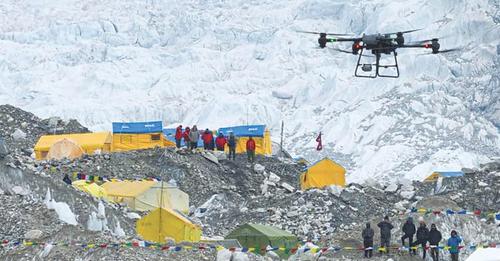
Chinese drone initiative to improve waste management on the world’s tallest peak.
Nepal is set to deploy Chinese-made drones to transport garbage from the slopes of Everest, marking the first time unmanned aerial vehicles (UAVs) will be used commercially in the country’s high-altitude zones.
This initiative announced by China’s leading drone manufacturer, Da Jiang Innovations (DJI), aims to reduce the risks faced by Sherpas and improve waste management on the world’s tallest peak.
Starting this autumn, heavy-lifting drones from DJI, will be used to transport trash from Ama Dablam, a 6,812-meter peak south of Everest.
The drones, which were successfully tested in April, can ferry up to 234 kg of waste per hour—a task that would typically take 14 porters six hours to complete.
In spring 2025, these drones will be put to work on Everest, supplying ropes and ladders to Camp I at 5,943 meters and bringing garbage back to the base camp at 5,364 meters.
This initiative, supported by a tripartite memorandum of understanding (MoU) between the Sagarmatha Pollution Control Committee, the Khumbu Pasang Lhamu Rural Municipality, and Airlift Technology Pvt Ltd, is seen as a critical step in improving safety and environmental conditions on Everest.
“After a successful test in April, we plan to use drones commercially in the Everest region,” said Jagat Bhusal, chief administration officer of the rural municipality that hosts Everest.
The drones, which produce a buzzing sound similar to a swarm of bees, offer a safer alternative to the treacherous work traditionally performed by Sherpas, particularly in the dangerous Khumbu Icefall.
The Khumbu Icefall, a notoriously perilous section of the climb to Everest’s summit, has claimed nearly 50 lives since 1953, according to the Himalayan Database and government records.
The use of drones is expected to significantly reduce the number of dangerous trips Sherpas must make through the icefall, where avalanches and ice collapses are frequent.
Despite concerns that drones might reduce job opportunities for local Sherpas, Bhusal emphasized that the primary goal is to save lives.
“Yes, there are concerns that the machines may actually cut jobs. But our sole purpose is to reduce potential deaths in the Khumbu Icefall, the danger zone,” he said.
Bhusal added that Sherpas would be trained to operate the drones, ensuring they remain an integral part of the operations.
The DJI FlyCart 30, the drone used in the tests, demonstrated its capability to transport up to 18 kg from Camp II and 30 kg from Camp I, although its performance varied with altitude.
The drones’ introduction is part of a broader effort to address the growing waste problem on Everest, exacerbated by climate change and the increasing number of climbers.
During the 2024 spring climbing season, nearly 100 tonnes of garbage were collected from Everest and Lhotse, with the Sagarmatha Pollution Control Committee (SPCC) managing 85 tonnes of waste from the base camp and higher camps.
The introduction of drones is expected to streamline waste collection and reduce the environmental impact on the mountain.
As the first commercial agreement under the MoU framework is set to be signed, the Khumbu Pasang Lhamu Rural Municipality has already invested Rs800,000 in the trial phase.
The use of drones is seen as a significant advancement in high-altitude waste management, offering a safer and more efficient solution to the challenges posed by Everest’s extreme environment.
Source: Express Tribune, August 10, 2024. https://tribune.com.pk/…/chinese-drones-to-transport…